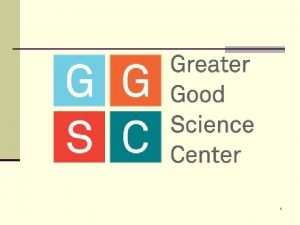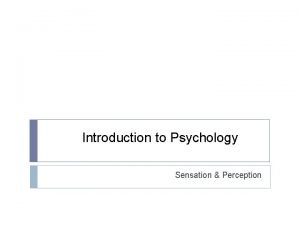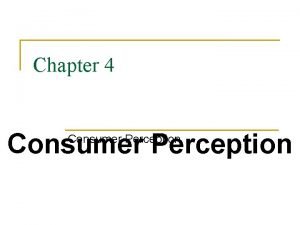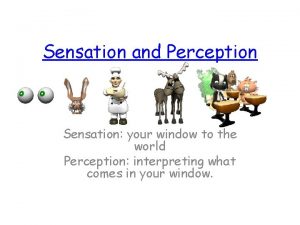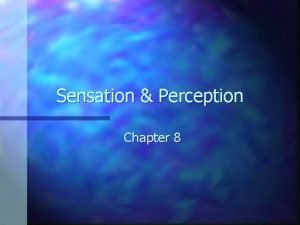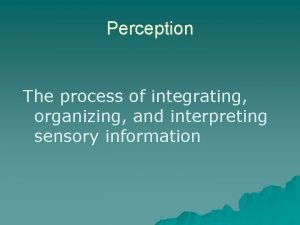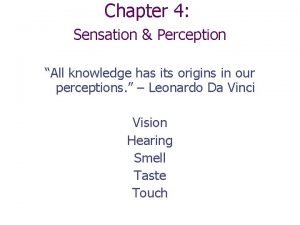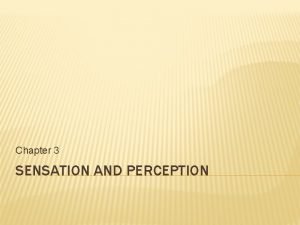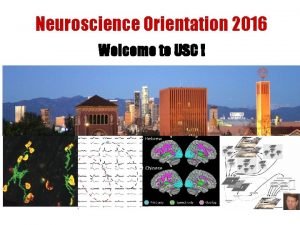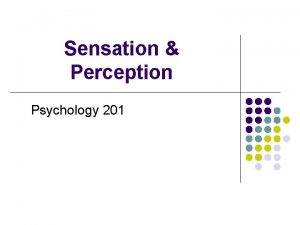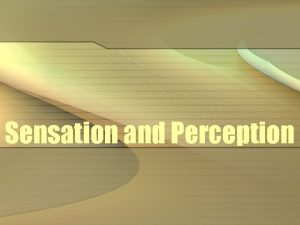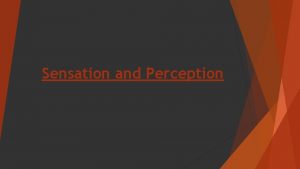Next course topics Psychology neuroscience Psychology sensation and






















- Slides: 22

Next course topics • Psychology – neuroscience • Psychology – sensation and perception • Psychology – personality theories and assessment • Psychology – abnormal psychology 1

Psychology – neuroscience THE NEURON • The Structure of a Neuron • How Neurons Communicate • Neurotransmitters THE NERVOUS SYSTEM AND THE ENDOCRINE SYSTEM • The Central Nervous System • The Peripheral Nervous System • The Endocrine Glandular System • Emotions and the Nervous System THE BRAIN • The Brain structure and the Cerebral Cortex • Specializations of the Left and Right hemispheres 2

Psychology – neuroscience • THE NEURON Cells that transmit information within the nervous system. • The brain consists of about 100 billion nerve cells, called neurons. Each neuron may receive information from thousands of other neurons. The number of possible communication connections between these billions of neurons is in the trillions. • Why are psychologists interested in how neurons work? To understand our behaviour and mental processes, we need to understand their biological underpinnings, starting with the cellular level, the neuron. How we feel, learn, remember, and think all stem from neuronal activity. 3

Psychology – neuroscience The Structure of a Neuron The brain and the nervous system are composed of two types of cells: • Neurons responsible for information transmission throughout the nervous system. They receive, send, and integrate information within the brain and the rest of the nervous system. • Glial cells (or glia) constitute the support system for the neurons (take away the waste products of neurons, keep the neurons’ chemical environment stable, and insulate them, allowing neurons to do their work more efficiently). It appears that not only do neurons and glial cells communicate but also that glial cells communicate with each other in a separate but parallel network to the neuronal network, influencing the brain’s performance. Glial cells also appear to influence the formation of synapses and to aid in determining which neuronal connections get stronger or weaker over time, both essential to learning and to storing memories. In addition, glial cells may play an important role in mental disorders such as schizophrenia and depression and in neurodegenerative diseases such as Parkinson’s and Alzheimer’s. Some ITA-ENG translational reflections Glial cells (or glia) = cellule gliali/neuroglia Malattie il cui nome deriva da cognomi plurisillabici Parkinson’s (disease) malattia (sottointeso dal genitvo sasson in ENG) di Parkinson Alzheimer’s, Alzheimer’s disease, / Huntington's disease or Huntington’s Crohn's disease: morbo di Crohn 4

Psychology – neuroscience The Structure of a Neuron *academic language, lexicon (guaina mielinica. assone, dendriti, corpo cellulare) “Dendrites are the fibers that project out of the cell body like the branches of a tree. Their main function is to receive information from other neurons. The dendrites pass this information on to the cell body, which contains the nucleus of the cell and the other biological material that keeps the cell alive. The cell body also decides whether or not to pass the information from the dendrites on to other neurons. If the cell body decides to pass along the information, it does so by way of the axon—the long, singular fiber leaving the cell body. At its end, the axon subdivides into axon terminals, branchlike endings. The main function of the axon is to conduct information from the cell body to the axon terminals in order to trigger the transmission of information with other neurons by means of electrical impulses. Axons vary greatly in length, with the longest ones going from the spinal cord to the toes. The myelin sheath is an insulating layer covering an axon that allows for faster neural impulses. ” 5

Psychology – neuroscience How neurons work *academic language (vescicola, sinapsi, ricaptazione, neurone di moto, neurone recettore ) 6

ESP – Psychology – neuroscience Neurotransmitters “Fifty to 100 different chemicals in our nervous system function as neurotransmitters. The ones we know most about are acetylcholine, dopamine, serotonin, norepinephrine, GABA (gamma-aminobutyric acid). Some disorders and diseases involve excessive activity or a deficit in activity for particular neurotransmitters. In addition, drugs and poisons achieve their effects by changing the activity level of particular neurotransmitters in either agonistic or antagonistic ways. Agonists increase the level of neurotransmitter activity; antagonists decrease it. This neuronal chemistry is the source of all of our behavior and mental processes, but we are only aware of its products (our behavior and mental processing) and not of the intercellular chemistry itself. ” *academic language, ESP lexicon + morphology (chemical terms formation through acronyms, compounding and /blending i. e. GABA (gamma-aminobutyric acid), norepinephrine) 7

ESP – Psychology – neuroscience THE NEURON • The Structure of a Neuron • How Neurons Communicate • Neurotransmitters THE NERVOUS SYSTEM AND THE ENDOCRINE SYSTEM • The Central Nervous System • The Peripheral Nervous System • Emotions and the Nervous System • The Endocrine Glandular System THE BRAIN • The Brain structure and the Cerebral Cortex • Specializations of the Left and Right hemispheres 8

ESP – Psychology – neuroscience THE NERVOUS SYSTEM *academic language, ESP lexicon + morphology (acronyms) “The nervous system first divides into: q the central nervous system (the spinal cord and brain) q the peripheral nervous system (the remainder of the nervous system throughout the body). The peripheral nervous system has two parts: • the somatic (or skeletal) nervous system • the autonomic nervous system. The autonomic nervous system also has two parts: § the sympathetic nervous system § the parasympathetic 9 nervous system. ”

Psychology – neuroscience THE NERVOUS SYSTEM *academic language, ESP lexicon “Both parts of the CNS, the spinal cord and the brain, are totally encased in bone— the spinal cord within the spinal column and the brain within the cranium— for protective reasons. In addition, for further protection, both are surrounded by cerebrospinal fluid for cushioning. ” “The brain is the control center for the entire nervous system: it carries out its commands through the neurons and provides information about the activities of the rest of the body and the world outside. The spinal cord spans from the stem of the brain down through the neck and the center of the spinal column. The spinal cord has two main functions. First, it serves as the conduit for both incoming sensory data and outgoing movement commands to the muscles in the body. This is why a spinal cord injury may result in paralysis and in difficulty breathing. Second, it provides for spinal reflexes. A spinal reflex is a simple automatic action not requiring involvement of the brain. A good example is the knee-jerk reflex in which a leg jerks forward when the knee is tapped. ” 10

– Psychology – neuroscience THE NERVOUS SYSTEM *academic language, ESP lexicon, terms borrowed from Medicine + morphology (acronymes) “The PNS gathers information for the brain about the external environment and the body’s internal environment through the sensory nerves; it also serves as the conduit for the brain’s commands to the rest of the body through the motor nerves. To carry out these tasks, the PNS has two parts working in concert with each other—the somatic (or skeletal) nervous system and the autonomic nervous system. The somatic (skeletal) nervous system carries sensory input from receptors to the CNS and relays commands from the CNS to the skeletal muscles to control their movement; the primary neurotransmitter for these muscles is acetylcholine. The autonomic nervous system regulates the functioning of our internal environment (glands and organs such as the stomach, lungs, and heart). The autonomic system has two parts: - the sympathetic nervous system, which is in control when we are very aroused, as in an emergency, and prepares us for defensive action, by expending energy. - the parasympathetic nervous system, which takes over when the aroused state ends to return the body to its normal resting state, by conserving energy. These two systems normally work together to maintain a steady internal state. The two systems are connected to essentially the same glands and organs, but generally lead to opposite effects. For example, the sympathetic leads to 11 pupil dilation, accelerated heartbeat, and inhibited digestion; the parasympathetic leads to pupil contraction, slowed heartbeat, and stimulated digestion. Given these actions, the sympathetic nervous system is usually referred to as the “fight-or-flight” system; it prepares us for one of these two actions in times of emergency. In contrast, the parasympathetic nervous system has some- times been called the “rest-and-digest” system. ”

ESP – Psychology – neuroscience EMOTIONS AND THE NERVOUS SYSTEM *academic language, use of formal synonyms, ESP lexicon, terms borrowed from Medicine “Emotions play an important part in our lives, and the autonomic nervous system, especially the sympathetic division, plays an important role in how we experience and express emotions bodily feelings that accompany various emotions (blood pressure rising, heart pounding, body trembling, etc. ). Psychologists usuallydefine an emotion as a complex psychological state that involves the interplay of three components: (1) a physical component—a state of physiological arousal triggered by the autonomic nervous system; (2) a behavioral component— the product of the somatic nervous system which provides outward expression of the emotion, including facial expressions, movements, and gestures; (3) a cognitive component— the brain appraisal of the situation to determine which emotion we are experiencing and how intensely we are experiencing it. ” 12

Psychology – neuroscience THE ENDOCRYNE SYSTEM (1) “The endocrine glandular system, is not part of the nervous system, but these two systems are connected in order to maintain normal internal functioning. The endocrine glandular system works with the autonomic nervous system in responding to stress, and it also plays an important role in such basic behaviors as having sex and eating and in normal bodily functions, such as metabolism, reproduction, and growth. Endocrine glands secrete chemical substances within the body into the bloodstream; these substances are the hormones. Some hormones (adrenalin and noradrenalin secreted by the adrenal glands) are chemically similar to some neurotransmitters (epinephrine and norepinephrine), but neurotransmitters are released at other neurons, while hormones have to travel through the bloodstream to reach their targets. For example, the male sex hormone, testosterone, travels from the male sex glands through the bloodstream to target sites in facial skin to stimulate hair growth. *academic language, ESP lexicon, terms borrowed from Medicine The endocrine glandular system is controlled by its connection with a part of the brain called the hypothalamus that controls the most influential gland in the endocrine system, the pituitary gland, which releases hormones essential for human growth, and also releases hormones that direct other endocrine glands to release their hormones. ” 13

Psychology – neuroscience THE ENDOCRYNE SYSTEM (2) “Other endocrine glands—such as the thyroid gland, the adrenal glands, the pancreas, and the sex glands—are located throughout the body. The thyroid gland, which affects our growth and maturation among other things, is located in the neck. The adrenal glands, which are involved in our metabolism and help to trigger the “fight-orflight” response with commands from the autonomic nervous system, are situated above the kidneys. The pancreas, located between the kidneys, is involved in digestion and maintaining our blood-sugar levels. The testes (in males) and ovaries (in females) secrete sex hormones. ” 14 *academic language, ESP lexicon, terms borrowed from Medicine

Psychology – neuroscience THE NEURON • The Structure of a Neuron • How Neurons Communicate • Neurotransmitters THE NERVOUS SYSTEM AND THE ENDOCRINE SYSTEM • The Central Nervous System • The Peripheral Nervous System • Emotions and the Nervous System • The Endocrine Glandular System THE BRAIN • The Brain structure and the Cerebral Cortex • Specializations of the Left and Right hemispheres 15

Psychology – neuroscience THE BRAIN The central core of the brain includes: *academic language, ESP lexicon (figure a) the brain stem (which includes the medulla and the pons), the thalamus attached to the top of the brain stem, the reticular formation that passes through both; (figure b) the cerebellum, which extends from the back of the brainstem; (figure c) the basal ganglia that surround the thalamus, the limbic system structures: hippocampus and amygdala 16

Psychology – neuroscience THE BRAIN “The central core of the brain includes: the brain stem spans from the spinal cord up to the thalamus. It includes the medulla and the pons. The medulla links the spinal cord to the brain, and is involved in regulating essential body functions such as heartbeat, breathing, blood pressure, digestion, and swallowing. This is why damage to the medulla or drug overdose that suppresses proper functioning of the medulla can result in death. Just above the medulla sits the pons: it serves as a passageway for neural signals between the cerebellum and the rest of the brain and is involved in sleep and dreaming. • • the thalamus, located at the top of the brain stem, serves as a relay station for incoming sensory information. As such, it sends each type of sensory information (visual, auditory, taste, or touch) to the appropriate location in the cerebral cortex. The only type of sensory information that does not pass through the thalamus is olfactory (smell) information. Smell information goes directly from the receptors in our nose to the cortex. • The reticular formation is a network of neurons running up the center of the brain stem and into the thalamus, which is involved in controlling our different levels of arousal and awareness. The reticular formation also plays a role in attention by deciding which incoming sensory information enters our conscious awareness. 17

Psychology – neuroscience THE BRAIN “The cerebellum is involved in the coordination of our movements, our sense of balance, and motor learning. It looks like two minihemispheres attached to the rear of the brain stem. The cerebellum has roughly the same surface area (if unfolded) as a single cerebral hemisphere does, but it is comprised of smaller neurons so it takes up far less space and only makes up about 10 percent of the brain’s weight. It has more neurons, an estimated 70 billion, than the rest of the brain combined. This is because the great majority of cerebellar neurons are granule neurons which are very small and can be densely packed into a smaller space. The cerebellum coordinates all of our movements, such as walking, running, and dancing. Damage to the cerebellum will lead to very unsteady, unbalanced movement. Alcohol depresses the functioning of the cerebellum, leading to the uncoordinated movements. In addition, the cerebellum is the location of motor learning, such as how to ride a bicycle or to type. There is also some emerging evidence indicating that the cerebellum may also play a role in integrating and coordinating sensory input and in mental functions such as planning. ” *academic language, ESP lexicon and medical terms focus on verbs 18

Psychology – neuroscience THE BRAIN *academic language, ESP lexicon The basal ganglia are on the outer sides of the thalamus and are concerned mainly with the initiation and execution of physical movements. Like the cerebellum, the basal ganglia are affected by alcohol. • Surrounding the top border (or “limbus” in Latin) of the brain stem is the limbic system, which is made up of the hypothalamus, the hippocampus and the amygdala. These limbic structures play an important role in our survival, memory, and emotions. The hypothalamus controls the pituitary gland (and so directs activity in the endocrine glandular system) and the autonomic nervous system to maintain the body’s internal environment, such as regulating body temperature. It also plays a major role in regulating basic drives such as eating, drinking, and having sex The hippocampus is involved in the formation of memories and has the capacity to generate new neurons, a process called neurogenesis. Located just in front of the hippocampal structures are the amygdala left and right structures. The amygdala plays a major role in regulating our emotional experiences, especially fear, anger, and aggression. It is also responsible for generating quick emotional responses. ” • 19

Psychology – neuroscience *academic language, ESP lexicon + medical terms; focus on verbal expressions THE BRAIN – THE CEREBRAL CORTEX (1) “The cerebral cortex is the control and information-processing center for the nervous system. This is where perception, language, memory, decision making, and all other higher -level cognitive processing occur. The cerebral cortex physically envelops all of the other brain structures, except for the lowest parts of the brain stem and cerebellum. The cerebral cortex consists of layers of interconnected cells that make up the “bark” or covering of the brain’s two hemispheres, which are called cerebral hemispheres. The two hemispheres are separated on top by a deep gap but joined together farther down in the middle by the corpus callosum, a bridge of neurons that allows the two hemispheres to communicate. ” 20

*academic language, ESP lexicon + medical terms ESP – Psychology – neuroscience THE BRAIN – THE CEREBRAL CORTEX (2) “The cerebral cortex two hemispheres are divided into four defined parts, called lobes. They are the same in both hemispheres and are named after the specific bone area in the skull that overlies them. Two distinctive fissures (gaps) serve as boundary markers for three of the lobes. The central fissure (also called the fissure of Rolando) and the lateral fissure (also called the Sylvian fissure) 1. the frontal lobe is located in the frontal area of each hemisphere; it includes the motor cortex, that is a strip of cortex directly in front of the central fissure, which allows us to move different parts of our body; 2. the parietal lobe is in back of the central fissure and above the lateral fissure. The somatosensory cortex is in this lobe: here our body sensations of touch, temperature, limb position, and pain are processed; Both the motor cortex and the somatosensory cortex are related to the two sides of our body in a contralateral fashion the left hemisphere controls the movement of, and processes body sensations from, the right side of the body; the right hemisphere does so for the left side of the body. 3. the occipital lobe is located in the lower back of each cerebral hemisphere. The primary visual cortex is in this lobe and is involved in visual processing; 4. the temporal lobe is located beneath the lateral fissure. The primary auditory cortex is in this lobe. The primary visual cortex and the primary auditory cortex are only the locations of the initial processing of visual 21 and auditory information. These primary areas pass the results of their analyses on to areas in the other lobes to complete the brain’s interpretation of the incoming visual or auditory information. These secondary cortical processing areas are part of what is termed the association cortex. ” (see next slide)

Psychology – neuroscience *academic language, ESP lexicon + medical terms THE BRAIN – THE CEREBRAL CORTEX (3) “The remaining area in the two hemispheres, about 70 percent of the cortex, is called the association cortex. The association cortex integrates the various types of information throughout all its areas, the higher-level cognitive processing, including perception, decision making, reasoning, speech, and language occurs in the association cortex. Scientists have studied the association cortex for over a century, but they are only beginning to understand the functions of some of the association areas (helped greatly by the recently developed scanning technologies, such as PET scans and f. MRI). Research has shown that the frontal lobes play a major role in our planning, reasoning, impulse control, and personality —especially its emotional aspects. It has been discovered that the speech and language areas are only in the left hemisphere in the majority of people, regardless of handedness. In particular, scientist have identified the Broca’s area in the left frontal lobe, that is responsible for speech production, and the Wernicke’s area in the left temporal lobe, which is responsible for the comprehension of speech and text. In addition, research has shown that there are processing differences between the two hemispheres: • the left specializes in speech, language, mathematical skills, and logic; moreover it analyzes stimuli into their elements or pieces. • the right specializes in spatial perception, face recognition, and drawing, and also in processing stimuli at the holistic, 22 global level. ” CONSCIOUSNESS PERSON’S AWARENESS INNER THINKING FEELING EXTERNAL
 X.next = x.next.next
X.next = x.next.next Copyright ?
Copyright ? Sop 3004 ucf
Sop 3004 ucf Neuroscience psychology
Neuroscience psychology What are sensations
What are sensations Course title and course number
Course title and course number Chapter 5 sensation and perception
Chapter 5 sensation and perception Reversible figure ground relationship
Reversible figure ground relationship Perceptual set ap psych
Perceptual set ap psych Sensation & perception crossword review
Sensation & perception crossword review Chapter 3 sensation and perception
Chapter 3 sensation and perception Sensation and perception
Sensation and perception Chapter 6 sensation and perception
Chapter 6 sensation and perception Perceptionn
Perceptionn Sensation and perception
Sensation and perception Opponent process theory
Opponent process theory Chapter 6 sensation and perception
Chapter 6 sensation and perception Chapter 8 sensation and perception
Chapter 8 sensation and perception Sensation and perception uu
Sensation and perception uu Chapter 4 sensation and perception
Chapter 4 sensation and perception Chapter 3 sensation and perception
Chapter 3 sensation and perception Nature neuroscience
Nature neuroscience Usc neuroscience research
Usc neuroscience research



